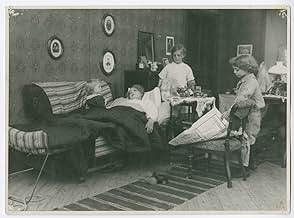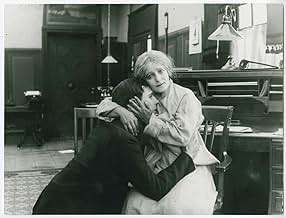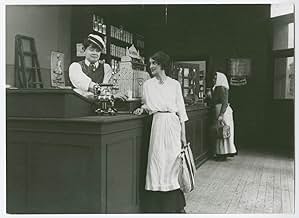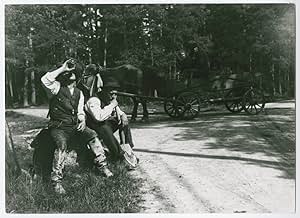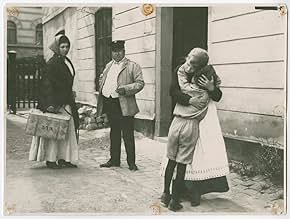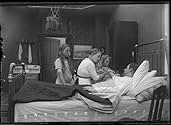IMDb-BEWERTUNG
7,0/10
1540
IHRE BEWERTUNG
Füge eine Handlung in deiner Sprache hinzuFinancial struggles separate a single mother from her children.Financial struggles separate a single mother from her children.Financial struggles separate a single mother from her children.
- Regie
- Drehbuch
- Hauptbesetzung
Empfohlene Bewertungen
A woman loses her husband and children in quick succession as the hand of fate lands her a tragic blow. Good direction, cinematography and acting for the time make this one of the essential silents and a standout in Scandinavian and world cinema. A must for fans of film history and movies in general.
Ingeborg Holm / Margaret Day (1913) :
Brief Review -
Master Victor Sjöström's Swedish Melodrama is one of the earliest notable works about a mother's Tragedy in the cinema world. I am a big fan of Victor Sjöström and his prominent classics from the 1920s decade. It gives me an immense pleasure to view his early films, which were made on basic formulas as per the requirements and understanding of the era. Ingeborg Holm forced me to think about all the films based on Mother's tale, and I quickly realised how influential it was. It was much before Chinese cinema made "SheNu" / "The Goddess" (1934) and Indian cinema made the classic "Aurat" (1940). However, Holm's story is not that broad. It sticks to the basics while dealing with a relatable and emotional topic like motherhood. When I tried to find out the similarities between this film and other ones, I found the Marathi film "Chimni Pakhare" close to it, but then the main character had to go through different conflicts. The best close answer was the Telugu flick, "Jeevana Jyothi" (1975), which also had a double role boost. Imagine, a film from the 1910s decade influencing modern well-known films. The film is about a mother with three children who had to send her children to foster homes due to the financial crisis after her husband's death. The insanity angle is also used well by mixing it with high-end melodrama. I remember Hilda Borgström from Victor's "The Phantom Carriage" (1921), but today I noticed that her face and expressions are familiar with those of Lillian Gish. Her face kept reminding me of Gish, who also happened to work during the same period of time. Victor Sjöström's film has everything to make a classy watch, but it missed the classic tag by just an inch, in my opinion. Nevertheless, a great work from the early stages of movies that set many iconic formulas once and for all.
RATING - 7.5/10*
By - #samthebestest.
Master Victor Sjöström's Swedish Melodrama is one of the earliest notable works about a mother's Tragedy in the cinema world. I am a big fan of Victor Sjöström and his prominent classics from the 1920s decade. It gives me an immense pleasure to view his early films, which were made on basic formulas as per the requirements and understanding of the era. Ingeborg Holm forced me to think about all the films based on Mother's tale, and I quickly realised how influential it was. It was much before Chinese cinema made "SheNu" / "The Goddess" (1934) and Indian cinema made the classic "Aurat" (1940). However, Holm's story is not that broad. It sticks to the basics while dealing with a relatable and emotional topic like motherhood. When I tried to find out the similarities between this film and other ones, I found the Marathi film "Chimni Pakhare" close to it, but then the main character had to go through different conflicts. The best close answer was the Telugu flick, "Jeevana Jyothi" (1975), which also had a double role boost. Imagine, a film from the 1910s decade influencing modern well-known films. The film is about a mother with three children who had to send her children to foster homes due to the financial crisis after her husband's death. The insanity angle is also used well by mixing it with high-end melodrama. I remember Hilda Borgström from Victor's "The Phantom Carriage" (1921), but today I noticed that her face and expressions are familiar with those of Lillian Gish. Her face kept reminding me of Gish, who also happened to work during the same period of time. Victor Sjöström's film has everything to make a classy watch, but it missed the classic tag by just an inch, in my opinion. Nevertheless, a great work from the early stages of movies that set many iconic formulas once and for all.
RATING - 7.5/10*
By - #samthebestest.
Again, this is an early not-that-bad drama from Sjostrom about a person driven mad by tragic circumstances. It has a nice sense of restraint, especially for its era, with a fine performance by Hilda Borgstrom and a well-paced story. Nothing about the movie sucks. It just takes a little something extra for me to get involved with a silent film... some sort of avant-garde twist or dazzling technique or some thrilling action. Yeah, it's a good plot with a sympathetic protagonist, but my heart just wasn't in it. I can't imagine anyone besides a Sjostrom scholar watching this more than once.
6/10
6/10
Beautiful background music added to this Swedish silent film from 1913. This is first silent film I've seen and I didn't know what to expect. To my surprise, I was able to stay engaged for the full 73 mins and ended up enjoying the style in which the film is presented. The story of a widowed mother tugs at your heartstrings and is a bold commentary on the treatment of lower-class individuals (particularly women) at the time. Would recommend this film to anyone interested in deepening their understanding of European film from the early 20th century. I would not recommend this film to anyone looking to tune out to a relaxing (somewhat short) film.
The classic narrative films so familiar in "The Golden Age of Hollywood" movies had its beginning in October 1913 with Sweden's "Ingeborg Holm." Writer/director Victor Sjostrom adapted the Nils Krok 1906 play about a family who sinks to the depths of poverty after the father dies just as he assumes ownership of a store.
What sets "Ingeborg Holm" apart from the movies produced previously to the autumn of 1913 was the breath of its plot. Instead of taking a slice of a full-scale biography of the characters and producing a film on one particular stand alone event, here Sjostrom portrays an entire family's history, beginning when the head of the household receives bank funding to begin his enterprise. He continues the plot until years later, concluding in an emotional reunion with the mother and her long-absent son.
"Ingeborg Holm" fits all the criteria in cinema's full narrative definitions. A classic narrative begins by introducing all the characters who will propel the plot forward, just as Sjostrom illustrated with the comfortable middle-class family embarking on its new enterprise. Narratives contain a triggering event which shakes things up. Here, the father dies and his assistant at the store rips off the family's profits. Sjostrom continues the narrative plot by showing the mother-led family sinking into poverty, with the kids shunt off to the poor house. Events lead up to the conclusion, where the director visually reveals Sweden's lack of a safety net for the country's poor caused by, through no fault of themselves, their hardships.
Hollywood would follow Sjostrom's pattern of full narrative movies, especially during its classic 1930's--1950's golden age. There are variations of the narrative pattern in movies today, but the Swedes were the first to put into practice on film what literature and drama had been delivering for centuries.
Today's movie viewers may be familiar with Sjostrom by his last appearance on the screen in Ingmar Bergman's 1957's "Wild Strawberries," where he had the leading role of an aging professor who rediscovers his past through a journey to receive a honorarium.
What sets "Ingeborg Holm" apart from the movies produced previously to the autumn of 1913 was the breath of its plot. Instead of taking a slice of a full-scale biography of the characters and producing a film on one particular stand alone event, here Sjostrom portrays an entire family's history, beginning when the head of the household receives bank funding to begin his enterprise. He continues the plot until years later, concluding in an emotional reunion with the mother and her long-absent son.
"Ingeborg Holm" fits all the criteria in cinema's full narrative definitions. A classic narrative begins by introducing all the characters who will propel the plot forward, just as Sjostrom illustrated with the comfortable middle-class family embarking on its new enterprise. Narratives contain a triggering event which shakes things up. Here, the father dies and his assistant at the store rips off the family's profits. Sjostrom continues the narrative plot by showing the mother-led family sinking into poverty, with the kids shunt off to the poor house. Events lead up to the conclusion, where the director visually reveals Sweden's lack of a safety net for the country's poor caused by, through no fault of themselves, their hardships.
Hollywood would follow Sjostrom's pattern of full narrative movies, especially during its classic 1930's--1950's golden age. There are variations of the narrative pattern in movies today, but the Swedes were the first to put into practice on film what literature and drama had been delivering for centuries.
Today's movie viewers may be familiar with Sjostrom by his last appearance on the screen in Ingmar Bergman's 1957's "Wild Strawberries," where he had the leading role of an aging professor who rediscovers his past through a journey to receive a honorarium.
Wusstest du schon
- WissenswertesNoted as the first true narrative film, its remarkable narrative continuity would characterize the style now known as classical Hollywood, which dominated the global film industry for the majority of the century.
- VerbindungenFeatured in Victor Sjöström - ett porträtt av Gösta Werner (1981)
Top-Auswahl
Melde dich zum Bewerten an und greife auf die Watchlist für personalisierte Empfehlungen zu.
Details
- Laufzeit1 Stunde 36 Minuten
- Sound-Mix
- Seitenverhältnis
- 1.33 : 1
Zu dieser Seite beitragen
Bearbeitung vorschlagen oder fehlenden Inhalt hinzufügen


